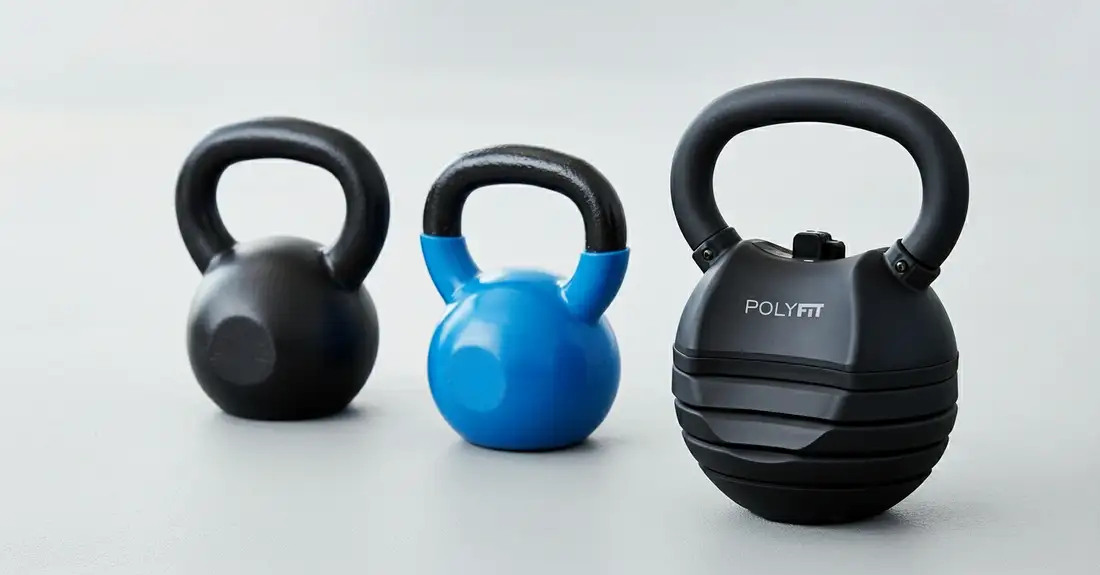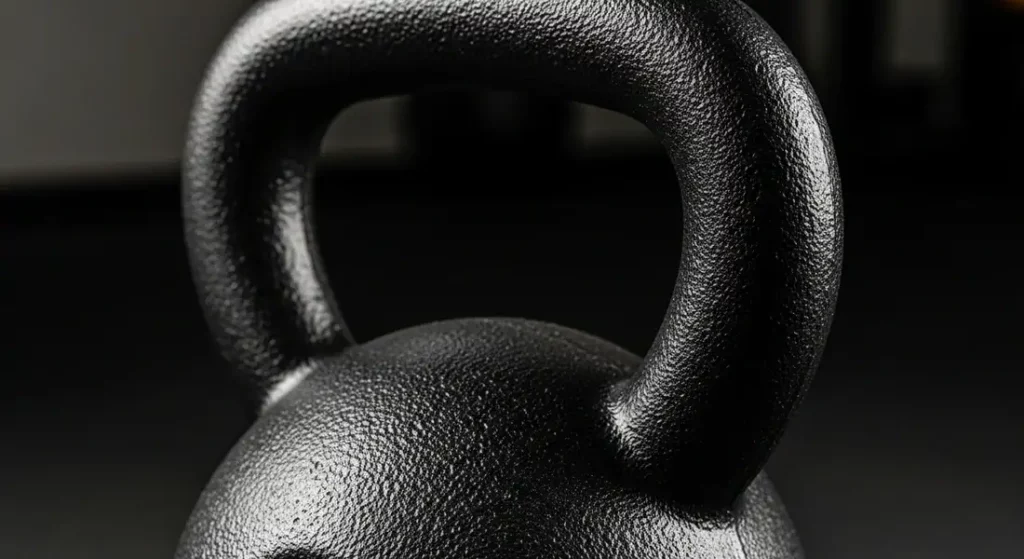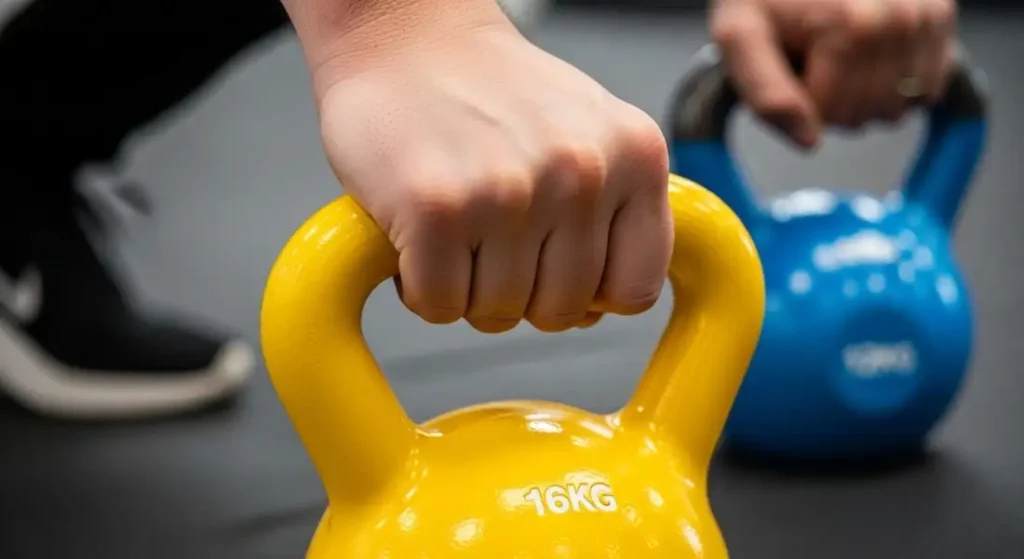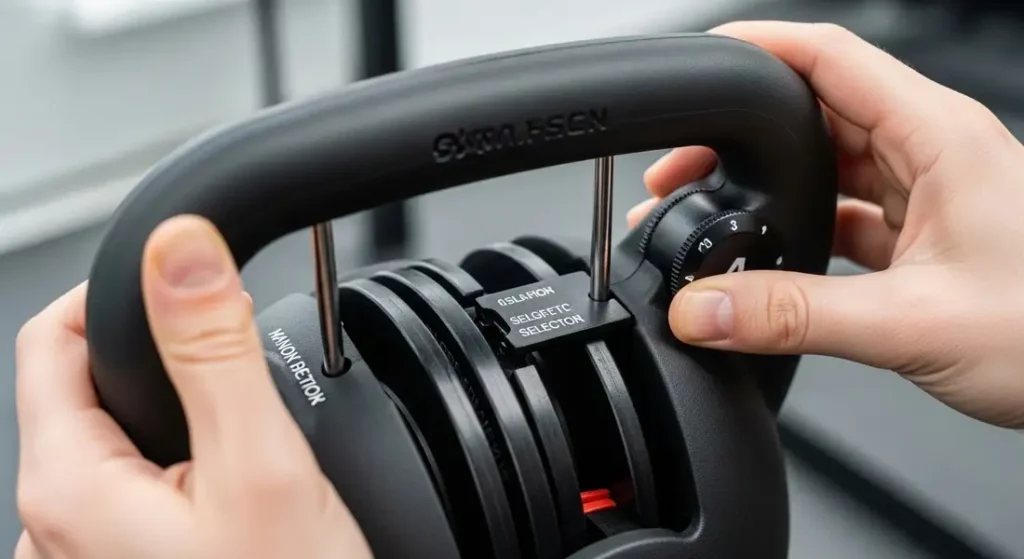Choosing Your First Kettlebell – A Simple Guide
So, you’re convinced of the benefits of kettlebell training and are ready to buy your first one.
But a quick search reveals a confusing array of options: rugged-looking black iron bells, colorful ones that are all the same size, and even some that look like a sci-fi gadget.

What’s the difference, and which one is right for a beginner?
Making the right choice is crucial.
The type of kettlebell you choose affects your grip, your form, and your overall experience.
In this guide, we’ll demystify the three main types of kettlebells so you can invest in the perfect tool for your home gym.
The Main Contenders – Cast Iron, Competition, and Adjustable
While you’ll see variations in coatings and colors, nearly all kettlebells fall into one of these three categories.
Let’s break them down.
1. Cast Iron Kettlebells – The All-Around Winner for Beginners

When you picture a kettlebell, you’re probably thinking of a classic cast iron model.
These are the workhorses of the kettlebell world and, for most people, the ideal starting point.
What Defines a Cast Iron Kettlebell?
Made from a single, solid piece of iron, these kettlebells are incredibly durable.
Their key characteristic is that the handle width and overall size of the bell increase as the weight goes up.
The handle is typically wider than on a competition bell, making it comfortable for two-handed exercises.
Who Should Use Them?
Cast iron kettlebells are perfect for beginners and general fitness enthusiasts.
The wider handle is ideal for learning the two-handed kettlebell swing, which is the foundational exercise for any beginner.
Pros and Cons of Cast Iron Kettlebells
| Pros | Cons |
| ✅ Highly durable and will last a lifetime | ❌ Inconsistent dimensions between weight sizes |
| ✅ Affordable and widely available | ❌ Handle thickness changes with weight |
| ✅ Wider handle is perfect for two-handed swings | ❌ Can be less comfortable for single-hand exercises |
| ✅ Versatile for a huge range of exercises |
2. Competition Kettlebells – For Honing Your Technique

Competition kettlebells are a more specialized tool.
They are designed for kettlebell sport (Girevoy sport), where efficiency and technique are paramount.
What Defines a Competition Kettlebell?
The most important feature is that every competition kettlebell is the exact same size, from an 8 kg bell to a 48 kg bell.
Only the weight inside changes.
They are made of steel and have a thinner, rectangular handle.
Each weight is color-coded for easy identification (e.g., pink for 8 kg, blue for 12 kg, yellow for 16 kg).
Who Should Use Them?
These are best for intermediate-to-advanced users who are serious about perfecting their technique in single-handed exercises like the clean, jerk, and snatch.
Because the bell never changes size, your hand and forearm position remains identical as you progress in weight, allowing you to master the movement pattern.
Pros and Cons of Competition Kettlebells
| Pros | Cons |
| ✅ Uniform size and shape builds consistent technique | ❌ More expensive than cast iron |
| ✅ Thinner handle is ideal for single-hand exercises | ❌ Can feel awkward for two-handed swings |
| ✅ Color-coded for easy weight identification | ❌ Less versatile for general fitness beginners |
3. Adjustable Kettlebells – The Space-Saving Solution

Adjustable kettlebells are the answer for anyone with limited space or a limited budget who still wants the versatility of multiple weights.
What Defines an Adjustable Kettlebell?
An adjustable kettlebell uses a system of removable weight plates or a dial mechanism to change the total weight of the bell.
You get a range of weights—for example, from 20 to 40 lbs—in a single piece of equipment.
Who Should Use Them?
These are best suited for home gym users who are critically short on space or who want the economic benefit of buying one piece of equipment instead of six.
The concept is similar to adjustable dumbbells, which are another fantastic option for a compact home gym.
Pros and Cons of Adjustable Kettlebells
| Pros | Cons |
| ✅ Excellent for saving space | ❌ Less durable due to moving parts |
| ✅ Cost-effective, replacing a full set of bells | ❌ Can feel clunky or rattle during swings |
| ✅ Allows for easy progressive overload | ❌ Changing weights can be slow and interrupt workout flow |
| ❌ Shape can be awkward for some comfort-based exercises |
Quick Comparison – Which Kettlebell is Right for You?
| Feature | Cast Iron | Competition | Adjustable |
| Best For | Beginners & General Fitness | Technique & Advanced Lifters | Small Spaces & Budgets |
| Handle Shape | Varies; wider | Uniform; thinner, rectangular | Varies; often plastic/clunky |
| Size | Changes with weight | Uniform across all weights | Uniform shell |
| Price Point | Most affordable | Mid-to-high range | High initial cost, but economical |
Key Takeaways for Making Your Choice
- For 90% of Beginners: A classic cast iron kettlebell is the best choice. It’s versatile, durable, and perfect for learning the most important foundational exercises.
- If You Are Serious About Technique: Once you’ve mastered the basics, a competition kettlebell can help you refine your single-arm movements.
- If Space is Your Biggest Concern: An adjustable kettlebell is a practical solution, but be aware of the potential trade-offs in feel and durability.
Frequently Asked Questions (FAQ)
Q: What about the kettlebells covered in vinyl or neoprene?
A: These are simply cast iron kettlebells with a protective coating. This coating can be a great feature to protect your floors from scratches. However, ensure the handle itself is not coated, as a vinyl handle can become slippery when you sweat.
Q: Does the brand of kettlebell matter for a beginner?
A: For a basic cast iron bell, quality is fairly consistent. The most important thing to look for is a single-cast kettlebell (made from one piece of metal) with a smooth handle free of seams or sharp edges that could tear up your hands. Reputable fitness brands generally have better quality control.
Ready to Pick Your Weight?
Now that you’ve decided on the type of kettlebell that best fits your goals and space, the next critical step is choosing the right starting weight.
Next Step: Continue to our comprehensive guide on Selecting Your First Kettlebell Weight (Common Beginner Mistakes) to make sure you start safely and effectively.
